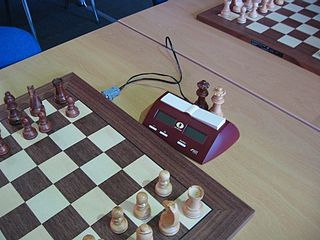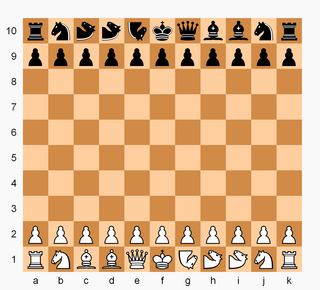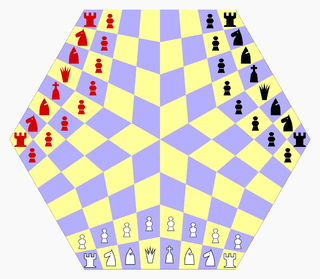
Alice chess is a chess variant invented in 1953 by V. R. Parton which employs two chessboards rather than one, and a slight alteration to the standard rules of chess. The game is named after the main character "Alice" in Lewis Carroll's work Through the Looking-Glass, where transport through the mirror into an alternative world is portrayed on the chessboards by the after-move transfer of chess pieces between boards A and B.
Progressive chess is a chess variant in which players, rather than just making one move per turn, play progressively longer series of moves. The game starts with White making one move, then Black makes two consecutive moves, White replies with three, Black makes four and so on. Progressive chess can be combined with other variants; for example, when Circe chess is played as a game, it is usually progressively. Progressive chess is considered particularly apt for playing correspondence chess using mail or some other slow medium, because of the relatively small number of moves in a typical game.
Stalemate is a situation in chess where the player whose turn it is to move is not in check and has no legal move. Stalemate results in a draw. During the endgame, stalemate is a resource that can enable the player with the inferior position to draw the game rather than lose. In more complex positions, stalemate is much rarer, usually taking the form of a swindle that succeeds only if the superior side is inattentive. Stalemate is also a common theme in endgame studies and other chess problems.
Tamerlane chess is a medieval chess variant. Like modern chess, it is derived from shatranj. It was developed in Central Asia during the reign of Emperor Timur, and its invention is also attributed to him. Because Tamerlane chess is a larger variant of chaturanga, it is also called Shatranj Al-Kabir, as opposed to Shatranj as-saghir. Although the game is similar to modern chess, it is distinctive in that there are varieties of pawn, each of which promotes in its own way.
Maharajah and the Sepoys, originally called Shatranj Diwana Shah and also known as the Mad King's Game, Maharajah chess, or Sarvatobhadra "auspicious on all sides", is a popular chess variant with different armies for White and Black. It was first played in the 19th century in India. It is a solved game with a forced win for Black.
Kriegspiel is a chess variant invented by Henry Michael Temple in 1899 and based upon the original Kriegsspiel developed by Georg von Reiswitz in 1812. In this game, each player can see their own pieces but not those of their opponent. For this reason, it is necessary to have a third person act as an umpire, with full information about the progress of the game. Players attempt to move on their turns, and the umpire declares their attempts 'legal' or 'illegal'. If the move is illegal, the player tries again; if it is legal, that move stands. Each player is given information about checks and captures. They may also ask the umpire if there are any legal captures with a pawn. Since the position of the opponent's pieces is unknown, Kriegspiel is a game of imperfect information.
Checkless chess, also known as prohibition chess, is a chess variant where neither player may give check unless it is checkmate. All other rules are as in regular chess. The origin of the game is unknown, dating from the mid-19th century. The variant is a popular problem theme, usually requiring a fairy mate.

In chess, promotion is the replacement of a pawn with a new piece when the pawn is moved to its last rank. The player replaces the pawn immediately with a queen, rook, bishop, or knight of the same color. The new piece does not have to be a previously captured piece. Promotion is mandatory when moving to the last rank; the pawn cannot remain as a pawn.
Knight relay chess is a chess variant invented by Mannis Charosh in 1972. In this game, knights relay their power to friendly pieces.

Hexagonal chess is a group of chess variants played on boards composed of hexagon cells. The best known is Gliński's variant, played on a symmetric 91-cell hexagonal board.
Monochromatic chess is a chess variant with unknown origin. The initial board position and all rules are the same as in regular chess, except that pieces that begin on a black square must always stay on a black square and pieces that begin on a white square must always stay on a white square. This would mean that knights can never move, but The Classified Encyclopedia of Chess Variants says that knights make a double jump. It has been suggested that a knight be replaced with a (3,1)-leaper (camel).
Three-player chess is a family of chess variants specially designed for three players. Many variations of three-player chess have been devised. They usually use a non-standard board, for example, a hexagonal or three-sided board that connects the center cells in a special way. The three armies are differentiated usually by color.
In chess and chess variants, a bare king is a king whose player has no other remaining pieces.

The following outline is provided as an overview of and topical guide to chess:

Wildebeest chess is a chess variant created by R. Wayne Schmittberger in 1987. The Wildebeest board is 11×10 squares. Besides the standard chess pieces, each side has two camels and one "wildebeest" - a piece which may move as either a camel or a knight.

Chessence is a chess variant invented by Jim Winslow in 1989. The board is a 6×9 rectangle of squares with eight squares missing. Each player has a king and nine men with initial setup as shown, including three men initially not yet in play at the side of the board. To win, a player must checkmate or stalemate the opponent.

Tri-chess is the name of a chess variant for three players invented by George R. Dekle Sr. in 1986. The game is played on a board comprising 150 triangular cells. The standard chess pieces are present, minus the queens, and plus the chancellor and cardinal compound fairy pieces per side.

Three-man chess is a chess variant for three players invented by George R. Dekle Sr. in 1984. The game is played on a hexagonal board comprising 96 quadrilateral cells. Each player controls a standard army of chess pieces.

Quatrochess is a chess variant for four players invented by George R. Dekle Sr. in 1986. It is played on a square 14×14 board that excludes the four central squares. Each player controls a standard set of sixteen chess pieces, and additionally nine fairy pieces. The game can be played in partnership or all-versus-all.

Hostage chess is a chess variant invented by John A. Leslie in 1997. Captured pieces are not eliminated from the game but can reenter active play through drops, similar to shogi. Unlike shogi, the piece a player may drop is one of their own pieces previously captured by the opponent. In exchange, the player returns a previously captured enemy piece which the opponent may drop on a future turn. This is the characteristic feature of the game.












